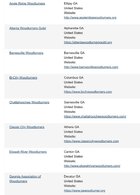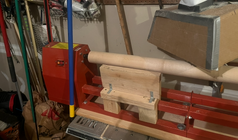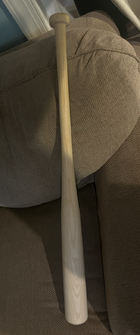My son is wanting to make his own baseball bats so I am looking for a lathe that would be suitable for doing that. I went to some local woodworking stores and got conflicting information so I thought I would ask here what I would need? I am open to new or used. Thanks
-
December 2025 Turning Challenge: Single Tree! (click here for details) -
Congratulations to Bob Henrickson, People's Choice in the November 2025 Turning Challenge (click here for details) -
Congratulations to Dave Roberts for "Low Rider" being selected as Turning of the Week for December 1, 2025 (click here for details) -
Welcome new registering member. Your username must be your real First and Last name (for example: John Doe). "Screen names" and "handles" are not allowed and your registration will be deleted if you don't use your real name. Also, do not use all caps nor all lower case.
You are using an out of date browser. It may not display this or other websites correctly.
You should upgrade or use an alternative browser.
You should upgrade or use an alternative browser.
Lathe recommendation
- Thread starter Grant Gunter
- Start date
Well, how is the budget? I would suggest used at first to see how he likes it, and then if he gets into it, go bigger. Find the nearest club, they are everywhere.... Some one is always upgrading and you might get a bunch of tools as well. I used to consider that the lathe was about half the cost of getting started. Now I think is is closer to 1/4. You will need a grinder and wheels for sharpening, You will need tools, skew and spindle roughing gouge at least. You will need abrasives. You may need a dust collector. If you can find a near by club, you may be able to get some mentoring as well.
robo hippy
robo hippy
I was hoping for around $1500 or so for the lathe itself.
- Joined
- Apr 27, 2004
- Messages
- 9,301
- Likes
- 6,055
- Location
- Lakeland, Florida
- Website
- www.hockenberywoodturning.com
You need to be sure you get a lathe that has a bed long enough. 35” is a big bat for most youth.I was hoping for around $1500 or so for the lathe itself.
The majors allow up to 42”
Minimum set of tools
Face shield
Safety glasses
Lathe with long bed
Spindle roughing gouge
Grinder to sharpen gouge
Drive center - lathe should come with a live center. Depending used lathes often come with drive centers too.
Sand paper
Dust mask
Useful tools
Long tool rest - avoids moving the standard rest dozens of times. Easy to make one.
1/2” spindle gouge - Easier to turn the knob and essential if you want to hollow out the end.
I’d suggest an electronic variable speed lathe with 36 +. between centers unless you want a bigger bat.
A used General 260, woodfast, Jet 1640. Would all be in the price range.
There are lots of ancient deltas that would do the job. Those should be a few hundred dollars but won’t have electronic variable speed - they have constant speed by moving the drive belt to different pulley positions.
A jet 1221 with a bed extension would work well too if you see one of those used.
I suggest you Contact the local chapters near you. They often have members who sell used lathes when the get newer ones.
Georgia chapters


Last edited:
You need to be sure you get a lathe that has a bed long enough. 35” is a big bat for most youth.
The majors allow up to 42”
Useful tools
Long tool rest - avoids moving the standard rest dozens of times. Easy to make one.
1/2” spindle gouge - Easier to turn the knob and essential if you want to hollow out the end.
I’d suggest an electronic variable speed lathe with 36 +. between centers unless you want a bigger bat.
USABLE bed length is a crucial consideration. Distance between centers does not really allow for space taken chucks / drive centers and live centers. I have turned 30-31" bats on a Jet 1642, but could not on a 3520.
The Jet 1642 is great lathe. Only used ones are available, generally at a good price -- I've seen them offered for around $1200. Variable speed.
I have turned 30-31" bats on a Jet 1642, but could not on a 3520.
Oh, get (or make) a bed extension! I used a couple of 1642s for years then bought a 3520b which came with a bed extension. Besides turning long spindles the extra length is great for the trays I make for each lathe. These sit on the ways but have a piece of wood that fits in the gap - allowing me to slide the tray down the bed but keeps it from tipping.
With the bed extension I’m able to turn long handles for shovels, etc. I have a photo of a hoe handle turning in progress in the document I posted recently in the “Tutorials” sub-forum on turning thin spindles. For that length I had to slide the headstock as far as I could off the end of the ways and slide the tailstock until it overhung the end of the bed extension!
But the bed extensions are expensive! However, I’ve seen pictures where people made extensions from hardwood and plywood. There are holes (threaded?) on the ends of the 3520b to fasten things like bed extensions. If other holes are needed, cast iron is VERY easy to drill and tap.
JKJ
Turning something as long as a baseball bat introduces some additional difficulties to the standard set of challenges. If your son has not turned much before, he should plan to start with smaller projects while he develops safe practices and decent technique. Getting mentorship help through your local turning club will pay huge dividends.
- Joined
- Feb 28, 2021
- Messages
- 1,760
- Likes
- 1,573
- Location
- Roulette, PA
- Website
- www.reallyruralwoodworks.com
I seem to also recall someone in these forums that mentioned/showed bolting TWO lathes together (I seem to recall they were powermatic or something) to make for very long spindles turning projects... Can't remember who it was but I'd imagine someone with some creative searching could find the post...Oh, get (or make) a bed extension! I used a couple of 1642s for years then bought a 3520b which came with a bed extension. Besides turning long spindles the extra length is great for the trays I make for each lathe. These sit on the ways but have a piece of wood that fits in the gap - allowing me to slide the tray down the bed but keeps it from tipping.
With the bed extension I’m able to turn long handles for shovels, etc. I have a photo of a hoe handle turning in progress in the document I posted recently in the “Tutorials” sub-forum on turning thin spindles. For that length I had to slide the headstock as far as I could off the end of the ways and slide the tailstock until it overhung the end of the bed extension!
But the bed extensions are expensive! However, I’ve seen pictures where people made extensions from hardwood and plywood. There are holes (threaded?) on the ends of the 3520b to fasten things like bed extensions. If other holes are needed, cast iron is VERY easy to drill and tap.
JKJ
Thanks. I'll be on the lookout for one. I've seen 3520's for sale but they're usually in the $2500+ range which is more than I'm looking to spend for this adventure.USABLE bed length is a crucial consideration. Distance between centers does not really allow for space taken chucks / drive centers and live centers. I have turned 30-31" bats on a Jet 1642, but could not on a 3520.
The Jet 1642 is great lathe. Only used ones are available, generally at a good price -- I've seen them offered for around $1200. Variable speed.
Yes. I was planning on either going to a local club or taking a class or two at woodcraft or somewhere before attempting anything big but I figured a class would only go so far if I didn't have anything at home to practice on.Turning something as long as a baseball bat introduces some additional difficulties to the standard set of challenges. If your son has not turned much before, he should plan to start with smaller projects while he develops safe practices and decent technique. Getting mentorship help through your local turning club will pay huge dividends.
Am I correct in assuming that the extensions currently available for a jet 1640 won't fit a 1642?
I think around 33"-34" is the longest bat I would need to turn. Would I even need an extension for that?
There are a couple Oliver's for sale that I've seen with 72"+ centers but they appear to be in rough shape and I would have to measure to see if I even have room for something like that.
I think around 33"-34" is the longest bat I would need to turn. Would I even need an extension for that?
There are a couple Oliver's for sale that I've seen with 72"+ centers but they appear to be in rough shape and I would have to measure to see if I even have room for something like that.
Turning something as long as a baseball bat introduces some additional difficulties to the standard set of challenges. If your son has not turned much before, he should plan to start with smaller projects while he develops safe practices and decent technique. Getting mentorship help through your local turning club will pay huge dividends.
Yes. I was planning on either going to a local club or taking a class or two at woodcraft or somewhere before attempting anything big but I figured a class would only go so far if I didn't have anything at home to practice on.
I agree with Dean. I’ve been turning maybe 25 years or so and have learned the challenges of turning long things and ways to success. I’ve turned a few bats. (I recently posted a PDF in the Tutorials/Tips section here that deals mostly with small, thin spindles but touches on larger things. But something the size of a baseball bat is relatively easy compared to a very long spindle.
A class is good but I’ve not heard of one yet that taught how to do long things like baseball bats. Many are focused on bowls, hollow forms, boxes, little things like pens and stoppers. One-on-one with an instructor experienced in this type of turning would be far better. And before thinking about a baseball bat it’s better to start with the basics of turning and the tools. And you are correct, having your own lathe or access to a lathe is needed. (And remember, while this could be an “adventure” it may also be a passion waiting to be discovered!)
I’m not sure what is around Atlanta these days, but there is probably a good woodturning club within driving distance for you. There is one in Soddy-Daisy, TN (TriState woodturners, I think). A club is, of course, a great way to meet people, get instruction, sometimes find equipment for sale.
Also, you are not all that far from my place near Clinton, TN. (We’ve driven to the Atlanta area many times). If you get up this way sometime I can show you a few things. At the moment I’m a little overbooked until maybe mid to late Nov.
There are woodturning symposiums around too, one near Nashville, TN in Jan. You can learn lots at one of these! (maybe not much about turning baseball bats but a good deal about woodturning and tools in general)
JKJ
- Joined
- Apr 27, 2004
- Messages
- 9,301
- Likes
- 6,055
- Location
- Lakeland, Florida
- Website
- www.hockenberywoodturning.com
For many lathes you won’t. However bed length is something to check as there are lathes that have too short a bed.think around 33"-34" is the longest bat I would need to turn. Would I even need an extension for that?
For the Jet 1221 yes extension needed
For the Jet 1640 no extension needed.
The Jet numbers are size code. First 2 numbers are the diameter you can spin over the bet. 2nd 2 are length between centers.
Hi Grant, Considering the high cost of a professionally rated bat blank, ask your son to research making a Radial Bat - the result is much stronger than a solid wood bat, and even though the manufacturing process is fussy, it’s less expensive.My son is wanting to make his own baseball bats so I am looking for a lathe that would be suitable for doing that. I went to some local woodworking stores and got conflicting information so I thought I would ask here what I would need? I am open to new or used. Thanks
Looking forward, Paul
Those look interesting. We may play around with making some to see how they perform. They’re unfortunately illegal to use in a game although I doubt any umpire would have a clue about wood bat construction.
I think around 33"-34" is the longest bat I would need to turn. Would I even need an extension for that?
Friend with a 1642 put a chuck and live center on and check -- 34" should be no problem. No extension needed. And used 1642s are well within your price hopes
Yes. If the bat is painted both ends…Those look interesting. We may play around with making some to see how they perform. They’re unfortunately illegal to use in a game although I doubt any umpire would have a clue about wood bat construction.
I’m making a 32” Radial bat in Dec…plan is to clamp it with wet rawhide so as to generate consistent circular clamping pressure. Glue will be Gorilla PU glue.Yes. If the bat is painted both ends…
Can you post a picture when you’re done? I would like to see that.I’m making a 32” Radial bat in Dec…plan is to clamp it with wet rawhide so as to generate consistent circular clamping pressure. Glue will be Gorilla PU glue.
Yes - patience is the watchword, eh? I’ll post pics of some steps…Can you post a picture when you’re done? I would like to see that.
Not positive, but I would go with Titebond or Elmers. If I am correct, the polyurethane glues are not good at taking shock loads.Can you post a picture when you’re done? I would like to see that.
robo hippy
If you read this article from the Woodworking Network: “Radial Bat's Switch to PUR Is a Big Hit“, you’ll find surprising detail about glue and shock resilience. Very cool research.
- Joined
- Apr 27, 2004
- Messages
- 9,301
- Likes
- 6,055
- Location
- Lakeland, Florida
- Website
- www.hockenberywoodturning.com
Looks like good wood technologyIf you read this article from the Woodworking Network: “Radial Bat's Switch to PUR Is a Big Hit“, you’ll find surprising detail about glue and shock resilience. Very cool research.
Don’t have to decide label up or label down the radial is 360 degrees of side grain.
Also an open invitation to hide corking.
If I knew what corking was, I’ll be glad to hide it..,Looks like good wood technology
Don’t have to decide label up or label down the radial is 360 degrees of side grain.
Also an open invitation to hide corking.
If I knew what corking was, I’ll be glad to hide it..,

The Physics of Cheating in Baseball
Corked bats and juiced balls have long plagued baseball, but do they really help a player’s game? Four scientists found surprising answers
Corked bats are rumored to make the ball travel farther but it appears that it might just be in the players heads that it works. There is a similar legend with the ash vs maple bats. MLB guys don't swing Ash bats like the one's used by Ruth, Mays and Aaron anymore because Maple supposedly hits it farther. This hasn't been able to be proven in scientific tests though.
Cool read!
The Physics of Cheating in Baseball
Corked bats and juiced balls have long plagued baseball, but do they really help a player’s game? Four scientists found surprising answerswww.smithsonianmag.com
Corked bats are rumored to make the ball travel farther but it appears that it might just be in the players heads that it works. There is a similar legend with the ash vs maple bats. MLB guys don't swing Ash bats like the one's used by Ruth, Mays and Aaron anymore because Maple supposedly hits it farther. This hasn't been able to be proven in scientific tests though.
Hence, of the two bats I’m going to turn in Dec one will be A) Radial, & B) rock Maple
The interesting thing about the radial bat idea is you could experiment with all sorts of inserts inside there. Seems like you could cut a dado in each piece and insert a rubber cylinder or piece of titanium or whatever in the dado before glue up.
Cool read!
Hence, of the two bats I’m going to turn in Dec one will be A) Radial, & B) rock Maple
Draw me a picture of your idea, Grant. I’m having difficulty imagining it. Might what you’re suggesting be accomplished by drilling out the centre of the glue-up? or is your idea more subversive?The interesting thing about the radial bat idea is you could experiment with all sorts of inserts inside there. Seems like you could cut a dado in each piece and insert a rubber cylinder or piece of titanium or whatever in the dado before glue up.
I'll see of I can draw something up tomorrow when I get in front of my computer. I was going for something more subversive than the traditional corking which drills from the end and then plugs the hole. It seems like you should be able to cut a dado in each wedge that would end up being the length of the sweet spot of the bat. Maybe 3-4" long approximately 2-3" from end of the bat. You would then take the cylinder and insert it in the dado during glue up so there's no evidence that it's there from looking at the end of the bat.Draw me a picture of your idea, Grant. I’m having difficulty imagining it. Might what you’re suggesting be accomplished by drilling out the centre of the glue-up? or is your idea more subversive?
Having never made a radial bat I have no idea if it would work. Works flawlessly in my head though.
You’ve got a good head - your description is graphic and persuasive. I think it would work.I'll see of I can draw something up tomorrow when I get in front of my computer. I was going for something more subversive than the traditional corking which drills from the end and then plugs the hole. It seems like you should be able to cut a dado in each wedge that would end up being the length of the sweet spot of the bat. Maybe 3-4" long approximately 2-3" from end of the bat. You would then take the cylinder and insert it in the dado during glue up so there's no evidence that it's there from looking at the end of the bat.
Having never made a radial bat I have no idea if it would work. Works flawlessly in my head though.
- Joined
- Feb 6, 2010
- Messages
- 3,445
- Likes
- 2,512
- Location
- Brandon, MS
- Website
- threeringswoodshop.square.site
Actually according to a manufacturer the reason for the change is that ash bats will splinter and fly when broken. Maple on the other hand when broken have less velocity on the broken parts and break moderately evenly.
The Physics of Cheating in Baseball
Corked bats and juiced balls have long plagued baseball, but do they really help a player’s game? Four scientists found surprising answerswww.smithsonianmag.com
Corked bats are rumored to make the ball travel farther but it appears that it might just be in the players heads that it works. There is a similar legend with the ash vs maple bats. MLB guys don't swing Ash bats like the one's used by Ruth, Mays and Aaron anymore because Maple supposedly hits it farther. This hasn't been able to be proven in scientific tests though.
My understanding is that Maple is actually more dangerous than Ash because of the way it breaks. MLB adopted grain standards because of dangers of flying maple. As a result very few of the billets pass inspection for use in a MLB bat based on what I was told at the Louisville Slugger museum.Actually according to a manufacturer the reason for the change is that ash bats will splinter and fly when broken. Maple on the other hand when broken have less velocity on the broken parts and break moderately evenly.

Batter Up: Ash or Maple? | The Outside Story
Those of us who enjoy forestry and baseball get a kick out of watching professional ballplayers stride to bat holding little pieces of the… This content is av
northernwoodlands.org
I spent about $225 on a vevor wood lathe, and another 225 on tools, self modification, a grinder, etc. Mounted it on an old table saw. Took a small shop vac, extended the hose with a plastic downspout, and made a cardboard hood for dust
Last edited:
The tool rest was a piece of crap, and not long enough, so I had to just make a coupe out of 2 x4s.

My pride and joy. You can see the rigged up hood, custom tool rest (I have two of them that are different heights). I also have a fan power oscillator I use to control the speed. You normally would have to physically open the motor door and adjust the belts if you want to change the speed. But she purrs like a kitten. Except that time she caught my wife’s car on fire.
Last edited:

